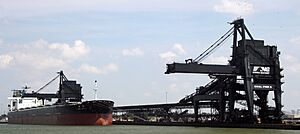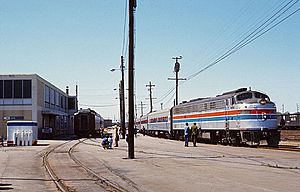Lambert's Point facts for kids
Lamberts Point is a piece of land in Norfolk, Virginia, right on the Elizabeth River. It's a really important spot because it has a huge facility for sending coal all over the world. There's also a neighborhood where people live and a golf course nearby. It's located south of Old Dominion University.
Contents
The Story of Lamberts Point
Lamberts Point got its name from a man named Thomas Lambert. He claimed 100 acres of land here way back on June 1, 1635, when Virginia was still a colony. Thomas Lambert was an important person in the community, serving in the local military and later in the government at Jamestown.
How Railroads Came to Lamberts Point
A young engineer named William Mahone helped build the Norfolk and Petersburg Railroad (N&P). This railroad was a big dream for the people of Norfolk because it would connect them to other cities like Petersburg and eventually even to the Mississippi River. Even though there were challenges like a terrible Yellow Fever Epidemic of 1855 and money problems, the railroad was finished by 1858.
The American Civil War caused a lot of damage to the railroads. After the war, William Mahone worked hard to rebuild the N&P and other connecting lines. He combined them into one big railroad called the Atlantic, Mississippi and Ohio Railroad (AM&O). Mahone knew that there was a lot of bituminous coal in southern West Virginia, and he wanted to bring it to Norfolk.
Coal Arrives in Norfolk
However, financial problems forced Mahone to lose control of his railroad. In 1881, a group from Philadelphia bought the AM&O and renamed it the Norfolk and Western Railway (N&W). The new owners also saw the huge potential of the West Virginia coal.
Under the leadership of Frederick J. Kimball, the N&W extended its tracks to reach the coal mines. The very first train car full of coal arrived in Norfolk in 1883. Soon, it became clear that a much bigger place was needed to load all this coal onto ships. So, land was bought at Lamberts Point, and the first coal pier opened there in 1886. The N&W tracks were built right to these new piers. A neighborhood was also built nearby for the railroad and coal workers and their families. By 1900, Norfolk was the top port for exporting coal on the East Coast! In 1911, Lamberts Point became part of the city of Norfolk.
The Norfolk and Western railroad grew very large. In the 1980s, it became part of Norfolk Southern Corporation, which is a major transportation company.
{{Wide image|Norfolk and Western Ry. Co. Coal Yards, at Lamberts Point, Norfolk, Va LCCN2007662913.tif|880px|N&W coal yards, at Lambert's Point with the Elizabeth River to the west, around 1915. This photo shows how big the coal operations were.]]
Norfolk Southern's Pier 6
Lamberts Point is home to Norfolk Southern's Pier 6. This is the biggest and fastest facility in the Northern Hemisphere for moving coal from trains to ships. It can handle an amazing 48 million tons of coal every year!
How Coal is Loaded
Unlike many other places, Pier 6 loads coal directly from the train cars onto the ships. They don't store it on the ground first. This system is very clever because it can mix different types of coal together, up to five different kinds at once. The pier is 1850 feet long and has three places for ships to dock. Two of these are for loading, and the third is for ships to wait.
The facility can hold about 6,200 loaded train cars. When it's working at full speed, its special machines can dump 1,200 train cars of coal every single day!
Passenger Train Service
For many years, the N&W railroad had a passenger station near Lamberts Point. It was located at 2200 Redgate Avenue. This station was used by the N&W until 1971. Later, from 1975 to 1977, the Amtrak Mountaineer train also used this station.
Lamberts Point Today
Today, other port facilities next to the coal operations are run by Lamberts Point Docks, Inc., which is part of Norfolk Southern.
The United States Navy also has a special station called the Lambert's Point Deperming Station in the Elizabeth River near Lamberts Point. This station helps Navy ships reduce their magnetic "signature." This makes them harder for certain types of mines to detect, keeping our sailors safer. While there are fewer coal mines in West Virginia now, Lamberts Point remains a very important place for moving coal.



